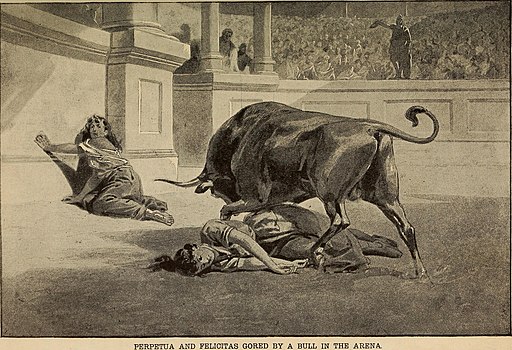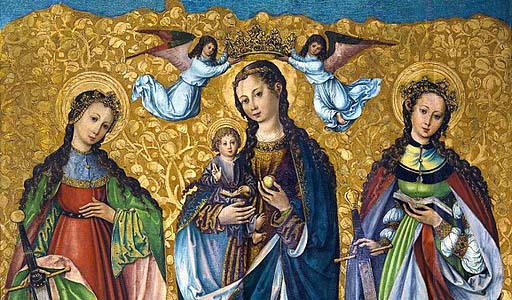
The above painting shows our Blessed Mother with two women who were also mothers: Saints Perpetua and Felicity. These two women, along with many other men and women, died during the first four centuries after the birth of Christ and are commemorated during the month of March. What can we, as Christians, learn from the martyrs this month?
How dangerous would it be for six people to present themselves at your local church and say they wanted to become Catholic? In the year 203, in the city of Carthage (in modern Tunisia), that was not a safe request. Although the law against being a Christian was not always enforced at every time and place in the Roman empire, at this time and in this place, it was.
During a roundup of Christians in Carthage, a group of four men and two women were only catechumens when they were arrested. One of the four men wrote an account of their arrest and imprisonment, and a witness later added a description of the deaths of all six. The account that has come down to us over the centuries is particularly moving, as it describes how one of the women, Perpetua, was visited by her father while she was in prison. Her father pleaded with her to renounce her faith in Christ, broke down in tears, and pointed out that her baby would never even know his own mother if she continued to persist in calling herself a follower of Jesus Christ. Perpetua loved her family, but she loved God too, and she knew that He deserved all her heart. She and her companions remained faithful throughout their imprisonment and were executed by being thrown into an arena with wild animals. The crowds in the amphitheater cheered while they were killed; Perpetua and Felicity were gored by a wild bull before being beheaded with their companions. The biography of Saint Perpetua and her companions was so widely-read by early Christians that Saint Augustine of Hippo later had to remind people that it was not part of Sacred Scripture. The feast day of this group of martyrs is March 7.
During the reign of the Roman emperor Valerian, the Roman empire was under attack by various armies. Valerian probably thought he was just being a good Roman, a good pagan, and a good emperor when he demanded that all citizens, even Christians, offer sacrifices to the Roman gods. Priscus, Malchus, and Alexander were Christian hermits living in the desert of Caesarea (modern Israel) when they heard about the persecution. In the year 260, they entered the nearby city to encourage the Christian faithful, proclaimed themselves to be Christians, and peacefully faced torture and martyrdom. They are remembered on March 28.
A few decades later, in the year 303, the Roman emperor Diocletian unleashed one of the most bitter and violent persecutions that the Church ever faced. We know that a group of Christians living in Caesarea (modern Israel) died together in that year (and presumably on their feast day, March 24), but we only know the names of six of them: Agapius, Alexander, Dionysius, Pausis, Romulus, and Timolaus.
Although the Roman emperor Constantine legalized the practice of Christianity in the year 313, his co-emperor, Licinius, reversed that order in the part of the empire that he ruled in the year 320. Licinius was about to fight an unsuccessful war for control of the empire against Constantine, but his word was law in his own territory. So when the local ruler ordered the Roman army stationed in Sebaste, Armenia, to offer sacrifice to the pagan gods, forty Christian soldiers of the Thunderstruck Legion refused. In the bitter cold, the men were ordered to strip off their clothes and lie on a frozen lake, with a huge bath of hot water waiting temptingly for them nearby. One man gave in, raced to the bath, and died instantly. Another soldier, seeing the bravery of the Christians, stepped forward to replace the dead man. All forty men are commemorated as martyrs on March 9.
In the year 339, Christians living in Alexandria, Egypt, were put to death because of the persecution of Christians ordered by the Roman emperor Constantius; their feast day is March 21. In the year 392 in the same city of Alexandria, a group of Christians were attacked and killed by a mob of pagans who were outraged that the Christians refused to worship the god Serapis; their feast day is March 17.
What do we learn from this random sampling of Christian martyrs who died together for their faith in the same month but centuries apart? Perhaps most obviously, we’re struck by the fortitude of these Catholic men and women, despite the incredible brutality inflicted upon them by their own rulers and neighbors for the crime of being Christian.
On the other hand, it may surprise some people to learn that the deaths of many of these martyrs was unexpected. While there were certainly times when persecution was so pervasive that becoming a martyr was a constant threat, many men and women probably entered the Church in hopes that the violence would pass them by. Arrest came for each of them on a seemingly ordinary day, when there were so many good things to live for. But, of course, there was a better world waiting for them than the one they left behind.
Perhaps one of the best lessons to take from the stories of the martyrs is given to us by the world of art. While the lovely painting of Saints Perpetua and Felicity in Heaven with the Blessed Mother shown above is gorgeous and inspires us to want to join them in the beauty of their new home, a more realistic image of martyrdom (below) provides a different sort of inspiration. It helps us remain thankful for the much smaller sufferings that we undergo in our daily lives and to ask the martyrs to help us face those pains with the peace of Christ.

